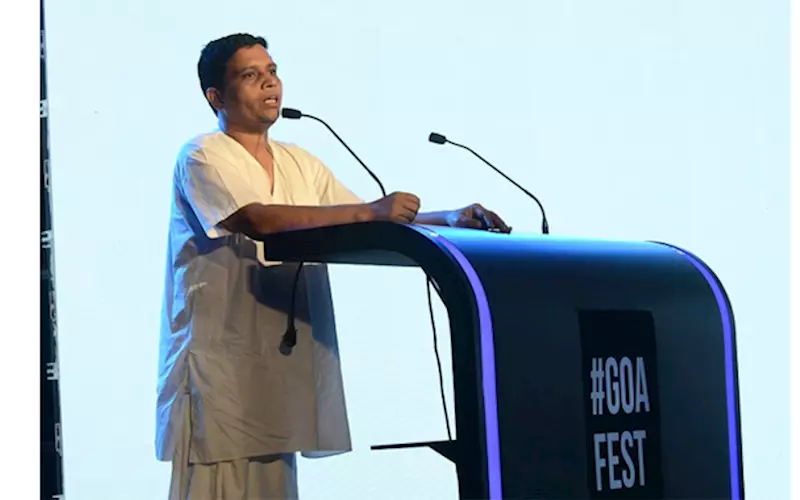Patanjali and ITC talk the talk at the Goa Fest
While India’s popular Ayurveda brand seemed to hint it will take the world by storm, the divisional chief executive of ITC’s focussed on ‘brand building in changing India’ at Goa Fest 2017.
07 Apr 2017 | By PrintWeek India
“The multinationals look at India as a market. For us India is our home,” said Acharya Balkrishna, MD, Patanjali Ayurved as he confirmed plans to take the homegrown brand global.
In his address to a packed room at the inaugural session at Goafest 2017, Balkrishna spoke passionately about how Patanjali Ayurved looks at a new market. “We do not do a market research and find out how big is the market before taking the plunge,” he said. Balkrishna who turned up on stage in a dhoti and kurta (traditional wear) pricked the bubble of many ad men by saying that his organisation did not make ads with glamorous men and women but rather focused on making products that were effective. Taking a swipe at Close-up toothpaste, he said that his toothpaste Dant-Kanti did not make people fall in love. “That’s not the role of a toothpaste. We only make a toothpaste that cleans your teeth effectively,” he said. He also took a dig at ITC for its ads on Bingo wafers saying they would not make chips that made consumer faces go crooked, much to the amusement of ITC executives sitting in the audience.
It's unlikely that Balkrishna, a student of Sanskrit and "not a management graduate" has heard about David Ogilvy. But he brought back memories of the advertising legend's famous "consumer is not a moron..." quote when he repeatedly spoke about looking at the consumer as a family member and doing things that would benefit society at large.
He said that the company followed a strategy – if it benefits the consumers and the suppliers, then the company will definitely benefit from that -- instead of beginning how a new product will benefit the organisation.
Giving the example of Amla juice, one of Patanjali Ayurved’s first launches, he said that it was started because of an unique issue facing the farmer community. The farmers wanted to cut down amla trees as the crop that was fetching them Rs 3 per kilo in the mid-1990s had not moved up even after more than a decade. The cost of labour was more than the realisation. Then Baba Ramdev, the yoga guru and the force behind Patanjali Ayurved decided to buy the entire produce from farmers. Balkrishna recalls that he was advised to tie-up with Punjab Agro and make juice from the crop. Baba Ramdev then went on television and told his audience on the benefits of Amla Juice. That endorsement sent sales shooting through the roof. He says that the price of the crop has now increased to nearly Rs 16 per kilo.
The other example that he gave was of reducing the price of Aloe Vera juice. When imported brands were charging and exorbitant sum of Rs 1500-1600, Patanjali managed to reduce the cost to as little as Rs 150. Replying to a question, he said the reduction in cost would not come with a compromise in quality. He said his team of more than 200 scientists took extreme care to ensure that consumers got the best products.
He exhorted ad agencies and marketers that before making consumers believe that the product was best for them, they had to internalise the question and ask themselves, “Would they get their family to use the product. Make conscience your gatekeeper,” he said.

ITC’s Hemant Mailk laid down the mantras for brand building in ‘changing India’ on day one of Goafest 2017.
He began his session by carefully describing the wordings of the topic at the Industry Conclave at the festival.
He said, “When I was given the topic, ‘role of brands in changing India’, I wondered whether it was about ‘changing India’ or ‘changing’ India. I’ve gone with ‘changing India’.” Transformation from hierarchical collectivists to individuals Among what he believes is changing in India, were two points about women getting more prominent, with a lady becoming a provider and the mother a decision maker. He also spoke about how youth culture is changing.
He said, “Change is a part of our transformation from hierarchical collectivists to individuals. And we are seeing this with the emergence of stars in sports that are focused on individuals (Badminton, tennis etc) and also the start-up culture right now. Changing government policies have helped strengthen our economy too.”
Malik then listed a few ‘exciting consumer trends’ that have come to the fore recently.
A) Busy lives - Consumers are seeking out products and services that help facilitate this busy lifestyle or those that free up time on less enjoyable tasks.
B) Personal space and time - Consumers are seeking out products that offer moments of comfort and encourage them to step back from the pressures of life.
C) Health living - Consumers are becoming increasingly skeptical of product claims.
D) Value worthiness - Consumers becoming more discerning and showing willingness to trade-up or even trade-down in they find an alternative offering more value for money.
E) Experience seeking - Consumers are seeking products that are novel and unusual. This extends to even when buying everyday groceries.
F) Young urban creatives - Consumers are breaking traditional life-cycle patters because of more liberal mindsets and greater opportunities and seeking out products that help this.
G) Changing age structures - Consumers are changing attitudes that defy stereotypes or actively seeking products that reflect their beliefs.
Malik had a rider though after discussing these points, that there could be a contradicting trend for each of the above points that need to be looked out for.
The divisional chief executive of ITC’s foods business then spoke about the pillars of brand building. He warned those that communication is just one pillar of brand building and brought out the importance of supply chain, product differentiation and being topical with case studies for three of ITC’s brands – Aashirvaad Atta, Yippee Noodles and Bingo. Aashirvaad saw two consumer problems. One was inconsistent wheat quality
The brand solved this by first using ITC’s e-choupal network to source the best grains directly from farmers. It then used superior blending capabilities to ensure a consistent mix. It then used crop holding to ensure consistency of blend across crop areas and crop year.
The other problem it saw was that consumers wanted their atta fresh.
The solution for this was centres of productions closer to centres of consumption as it looked beyond the obvious supply chain process to reduce time to market.
For Yippee, ITC had a problem of late entrance to the instant noodles market. Here the brand innovated by changing the shape of the product, get rid of stickiness and then added a customised flavor to the noodles. Three years and 1,300 block trails led to ‘non sticky noodles’. It added dehydrated vegetables (since mothers wanted to add them to their children’s meals) and also added a distinctive smell of Indian masala.
With Bingo, the company wanted to cater to the youth. It perceived ‘now’ to be a key word for its TG and hence tried staying relevant. The latest of this attempt came through a TVC which took on selfies.
Stating that their’s no amrit (magic) for building a great brand he urged the industry to ‘clearly define a role of the brand’.
He stated a few questions for the brand builders:
• Are you clear on what the brand stands for?
• Are you speaking to the right consumer?
• Are you providing with what he/she needs?
• Are you utilising every opportunity in the supply chain?
• Are your products relevant now and future ready?
Keeping all these questions in mind he added that the brand builders should at the same time also look to build profitability.
Source: Campaign India Team











 See All
See All